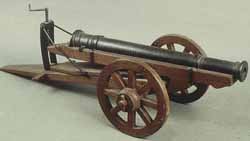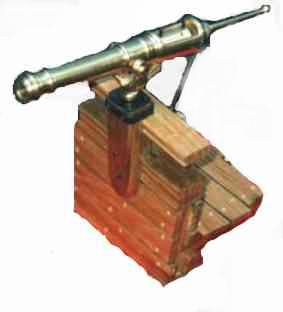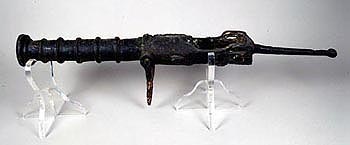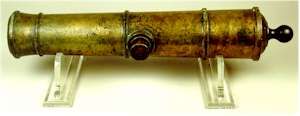|
There
appears to be little doubt that in Europe the first thunder clap of
artillery was heard in Spain, the first reliable report being of Mohammed IV
of Granada at the Alicante and Orihuela borders in 1331. Similarly,
artíllery was used by the Moors in the siege of Algeciras (13421344).
The first
mention written of naval artillery was in the skirmishes between Peter the
Ceremonious of Granada and Peter the Cruel of Castille in1359. Putting a
bombard on a ship of Peter of Granada contributed to the defeat of the fleet
of his enemy.
A little
later in 1371, the Castillian navy gained a brilliant victory against the
English at La Rochelle - principally due to the good use of artillery.
In
the History of Artillery four periods have been recognised
1 That of the Bombards,
from theír first use up to the beginning of the 16`" century;
2 That of the Culverin to the end of the 17`" century;
3 That
of Artillery based on the Royal System to the end of the 19t"
century;
4 Artillery
with Rifled Barrels.
BOMBARDS
Every
piece of artillery is composed of two main parts - the barrel and its mount.
The barrel is a long hollow tube; gunpowder is fed into the bottom of the
barrel with the projectile immediately next to it. When the powder is
ignited the projectile is ejected by the gases produced.
The oldest
known artillery pieces are the bombards or lombards, their most notable
characteristic being the separation of barrel and powder chamber. External
fittings enabled these to be lashed to each other and to the mounting ready
for firing.
|
|
These two components were not of solid metal but of
strips bound together by outside hoops - like a cask made of metal instead of
wood. (Hoop and stave construction)
In the mid-14t"
century these units began to be fashioned of solid metal. The metal used was
bronze (an alloy of copper and tin) and named fúslera. There were many
ironworkers who could make hoop and stave bombards but those made of solid metal
needed skílled workers - bell-makers who used the same alloy for both bells and
guns, (although that used for bells with
its higher tin content was
unsuitable as it caused many barrels to fracture - generally at the first firing).
|
 |
|
As for the mounting, it was simply a block
of wood on which the assembly was fixed. Elevation was initially effected by
placing wooden wedges beneath the front, changing later to a system of
frames and crossbeams which could be adjusted to various levels, the front
of the bombard resting on top. The mounting was initially called ajusta or
fuste in Aragon and, later in Castille, the general word cureña
(the name given to part of a crossbow) was used. |
 |
Firing
the bombard involved:
1
Filling the powder chamber to about three-quarters full.
2
Inserting a wooden plug on top of the powder, compressing it lightly
3
Joining the powder chamber to the barrel by passing ropes through the hoops,
lashing
them tightly,
then tying the whole to the mounting.
4 Putting the projectile into the muzzle and ramming it home.
5 Firing
the gun by putting a red-hot ¡ron into the external vent which, full of
powder,
communicated with the main charge.
|
|
It can be seen that there was quite a long delay between one shot and the
next and, apart from the above procedures, the gun had to be aimed. To
reduce the interval each bombard sometimes had two powder chambers so that
one was being prepared while the other was being fired. In spite of this the
rate of fire was very slow and it would seem that not more than eight or ten
shots per day were possible. |
|
The
projectiles fired by bombards were cannon balls or shot, of ¡ron or of
stone. Iron was the better but cannon balls presented production
difficulties when they needed to be very large. Stone production presented
fewer problems because stone-cutters were plentiful and having a quarry
nearby made the supply of stone shot simple. Leaded ¡ron shot (called
bodoques) was also used.
|
 |
|

|
Bombards
were almost exclusívely used for firing flat (straight) trajectories. Hígh
curved trajectories were
attained by a shorter-barrelled, wide calibre piece, generally bell-shaped,
called a mortar. This was also
of stave and hoop construction but the powder chamber was much narrower
than the barrel |
|
 |
Another
gun used at this time was the falconet whích had a framework
at
the rear supporting the powder chamber; this was called
the alcuza
At the end of this framework was a handle which
enabled
the falconet to be rotated about an axis.
|
 |
|
The
bombard was little improved during the 14`" and early 15t"
centuries. But later in the 15`" century there were two important
innovations: the calibre was slightly reduced at the muzzle end to increase
resistance and the use of ¡ron shot became more prevalent..
To give some idea of
the capabilities of artillery at this time, here are some statistics:
The weight
of a bombard could reach 6000 kg, that of the projectiles from 5 to 150 kg
in the case of stone shot and 250 kg if ¡ron shot were used. Their calibre
varied up to 580 m
The range
at the end of the 14`" century reached 1300 m, rísing to 2000 m at the end
of the 15" century. In the latter half of the 15t" century
lighter and more mobile pieces made their
appearance leading gradually to the acquisition of more of these and less
use of large guns. The 16`" century continued to produce improvements, the
guns being welded into one piece instead of two.
|
|

|
Another
innovation was the addition of trunions - two cylindrical projections
enabling the gun to pivot
vertically
and vary elevation. |
|
The mobile
gun carriages were developed to a pattern they were to keep, more or less,
for many centuries.
Most guns were no longer made by individual artisans but by purpose-built
govermnent establishments. Numerous arsenals were set up - notably in Malaga,
Medina del Campo, Barcelona and Burgos. Projectiles were always of ¡ron, and
from the mid-16th century the shell began to be used - a hollow sphere
filled with gunpowder. Cannon balls wrapped in sacking were also fired -
they caught fire and lit up the battlefield
THE
CULVERINS
Artillery
in those early times was used almost exclusively for siege warfare. For guns
to move with an army it was necessary to make them lighter , and to achieve
greater ranges the barrels were lengthened.
Thus
appeared the characteristic pieces of the period - the culverin, the cannon,
the sacers and the
sacabuches.
The
culverin was usually of bronze fashioned in one piece and muzzle-loaded.
There were about thirty different calibres and their range was 5000 m.
The sacers
and
sacabuches
were also
members of the culverin famíly, but of smaller bore. These could be
considered the forerunners of the infantry small arms. Those of greater
calibre than the culverin were called cannon; with a shorter barrel, made of
bronze and muzzleloading.
|
|
Culverin |
Cannon |
Sacabuches |
 |
 |
| Pasavolante |
Verso |
ARTILLERY BASED
ON THE ROYAL SYSTEM
If one
examines accounts of the artillery an army carríed, the vast diversity is
astonishing. Even those pieces with the same name and calibre were not
necessarily ídentical, the eharacteristics of each depending on the whim of the
maker or of the person making the requisition. The loading of artillery was very
eomplicated and firing was often interrupted at the height of an action.
Charles
V, in advance of his contemporaries, successfully brought a certain order into
the many different types of gun - which had grown to one hundred and sixty -
reducing them to a more manageable number. He established six categories, namely
of forty, twenty-six, twelve, six and three pounds plus a mortar.
This attempt
to simplify only partíally succeeded. In the time of Philip II, following the
same trend, seven categories were established: cannon and demicannon; culverins
and demi-culverins; sacers and demi-sacers, and falconets.At
the end of the 16t" century six categories existed: cannon (of 40,
35, 32 and
301b); demi -cannon (of 20, 18,
16 and 15); very small calibre cannon (of 10, 8and 7); culverins (of 24, 20, 18
and 16); demi-culverins (of 12, 10, 8 and 7) and
very small culverins (of
5, 4, 3 and 2).
In the
beginning of the 17'h century Philip III limited the number ofcannon
types but these reforms were again applied piecemeal.
At the end of the 17t"
and beginning of the 18t" centuries the production in
the
Royal Factories was centralised and they became the only arms manufacturers -
private manufacturers being excluded. Calibres were
regulated and reduced to an essential number. This followed the Naval Ordinance
of 1718.
The
calibre was expressed by the weight of the cannon ball. Thus if one talked of a
12 cannon, it meant a cannon firing a ball weighing 12 lb. The barrels continued
to be decorated and differed little from the previous period.
In 1743
another Ordinance was issued - decoration disappeared, the mounting was made
lighter, the variety of calibres was limited and the cartridge made its
appearance (shell and charge joined to form one unit for simplifed firing).
Artillery was classified as: Siege cannon, Field cannon, Howitzers, Mortars.












